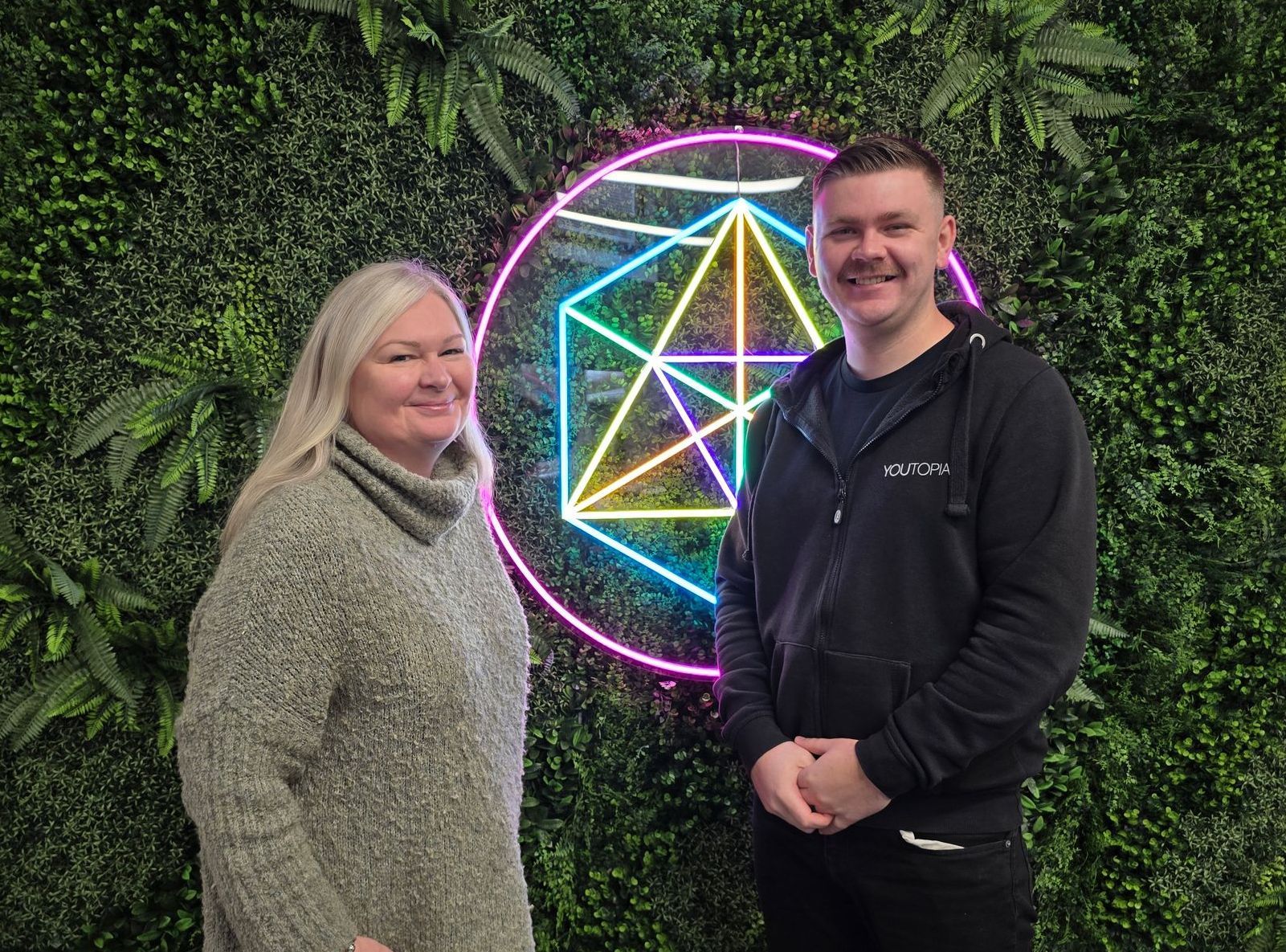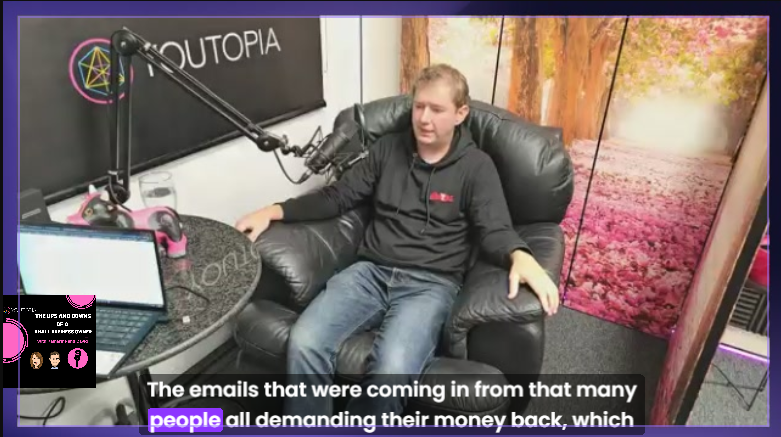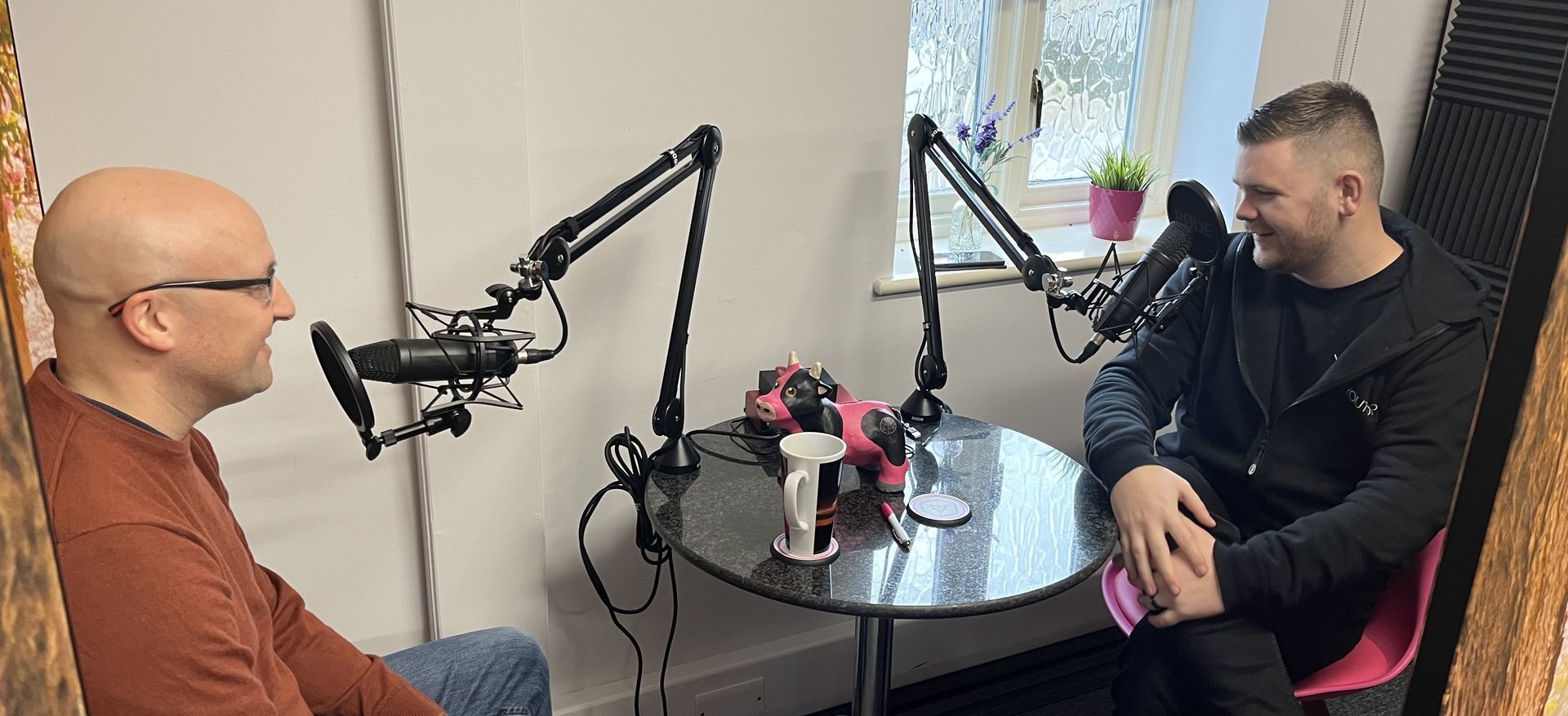"Unlock Success as an Entrepreneur: 7 Essential Steps to Achieve Your Goals"
Katherine's Journey to Business Success: Finding Balance in the Ups & Downs of Youtopia

Are you an entrepreneur looking for the key to success and growth? Have you been searching for the right resources to help you achieve your goals? Look no further! In this blog, I'll be detailing the journey of Katherine, a small business owner who has seen the highs and lows of what it takes to run a business. I'll outline the 7 essential steps Katherine used to unlock success and growth in her business - the Work-Life Balance Paradox system. You'll learn how she found her first five or ten clients, how she handled the challenge of hiring someone, and how she achieved a better work-life balance. So join me as I take you on this journey and unlock success as an entrepreneur!
About Katherine
Welcome to our podcast, the Ups and Downs of a Small Business Owner, where we explore the trials and tribulations of business owners. Today, we have Katherine, my business partner, on the show to talk about her journey of growing Youtopia. Katherine started her business five years ago with a mix of blind optimism, enthusiasm, and a desire to build something better. With her extensive experience in corporate and operational roles, as well as finance, Katherine had the perfect background to set up her own business. Now, five years later, Katherine has learnt many lessons about running a business and is here to share them with us. So let's dive in and find out what Katherine has to say about her journey!
Why is it important to know what resources are available to help entrepreneurs succeed?
For entrepreneurs and small business owners, it is essential to know what resources are available to help them succeed. Knowing what resources are available to help entrepreneurs is key to gaining the skills and knowledge needed to be successful. With access to the right resources, entrepreneurs can develop the strategies and tactics needed to run a successful business. Resources can also provide entrepreneurs with the tools, guidance, and resources to create a business plan, develop a marketing strategy, and create a budget. Having access to the right resources can also provide entrepreneurs with the necessary support and guidance needed to stay on track and reach their goals. Resources can help entrepreneurs stay informed of the latest trends and developments, giving them the information they need to make informed decisions. Additionally, resources can help entrepreneurs identify potential sources of funding, enabling them to access the capital they need to start and grow their business. By understanding and leveraging the resources available, entrepreneurs can set themselves up for success and achieve their goals.
Here are the steps you need to follow:
1. Identify the problem and the need for improvement.
2. Set a goal and create a plan.
3. Execute the plan and adjust it as needed.
4. Build relationships and get support.
5. Take calculated risks and don’t be afraid to fail.
6. Learn from mistakes and strive for continuous improvement.
7. Find a balance between work and personal life.
The first step in running a successful small business is to have a clear vision for the business and decide what it is you want to achieve. This should include defining what sets your business apart from the competition, setting goals for short-term and long-term success, and developing strategies for how to reach those goals. Furthermore, it is important to have an understanding of who your customers are and what their needs are in order to develop products and services that will meet their demands. Additionally, having a solid understanding of the industry and the trends that are shaping it is paramount to success. Knowing your competitors and their strategies can help you stay one step ahead. Finally, it is important to develop a team of individuals who are passionate about the business and the goals it is striving to achieve. Having a strong team of experienced and motivated individuals will help ensure the success of the business.
Once the vision and goals of the small business are established, it is important to develop a business plan. This plan should include the financials of the business and any potential risks, as well as the marketing and sales strategies that will be used to reach the target market. Additionally, it should include a timeline and budget allocation for the project to ensure that all tasks are completed on time and within the set budget. Furthermore, the plan should include any legal and insurance considerations necessary to start and operate the business. It is also essential to have systems and processes in place to ensure that business operations run smoothly. This includes creating a system for customer service and communication, as well as an inventory management system. Additionally, it is important to have a system of accounting and financial management in place to monitor the financial performance of the business and ensure that it is on track to meet its goals. Finally, the business must have a system for tracking customer feedback and reviews to ensure that the products and services are meeting customer expectations. By following these steps, a small business can ensure that it has the right infrastructure in place to ensure its success.
2. Identify the problem and the need for improvement.
Step 2: Identify the Problem and the Need for Improvement. From this transcript, it is clear that the business partner, Katherine, and the interviewer are facing a problem in regards to the hiring process. They have gone through the journey of hiring their first employee, which had its challenges and did not work out as expected. Katherine has identified that the root of the problem is that they were trying to find perfection, when that is almost impossible. In order to improve, she has identified the need to focus more on soft skills and attitudes of potential employees, as those are the core aspects necessary for success. Additionally, she has learned that the need to accept that the first employee may not be the forever employee, but instead hire people with the right attitude and teach them the other skills necessary. Finally, Katherine has identified that it is difficult to always switch off, but it is important to find a good work/life balance in order to remain present in life.
Step 3: Create A Plan for Improvement. Katherine has identified the need for improvement and now it is time to create a plan for how to move forward. First, the business partner and interviewer need to create a clear job description with the skills and attitudes they are looking for in a potential employee. Additionally, it is important to focus on the soft skills and attitudes of potential employees, as those are the key components of success. Furthermore, they should create a process to evaluate candidate’s soft skills and attitudes during the hiring process. This can be done by adding questions to the interview that focus on these aspects and by conducting an assessment to evaluate how the candidate will fit with their team. Finally, Katherine has identified the importance of finding a good work/life balance. To address this, the business partner and interviewer should establish a policy that allows employees to take breaks as needed and encourages them to switch off at the end of the day. Additionally, they should provide resources and support that allows employees to find a balance between work and life. By implementing these changes, the business partner and interviewer will be able to improve the hiring process and find employees with the right attitude and skills for their team.
3. Set a goal and create a plan.
Step 3 is setting a goal and creating a plan. This is a crucial step in starting and growing a business. It is important to have a clear goal and plan in mind in order to move forward and make progress. To set a goal and create a plan, it is important to start by asking yourself questions about the business. What do you want to achieve? What do you need to do to reach your goals? What resources and people will you need? It is also important to think about the timeline for reaching your goals. This timeline should include short and long-term goals that can be reviewed and adjusted if needed. After setting goals and creating a plan, it is important to execute it. This will involve taking actionable steps to reach those goals, such as networking, meeting potential clients, and hiring employees. Finally, it is important to measure progress and adjust the plan if needed. By setting a goal and creating a plan, it is possible to effectively manage a business and reach success.
Once a goal and plan are set, it is important to be proactive in making sure the plan is followed. This means taking actionable steps to reach those goals as soon as possible. It is also important to have an accountability system in place to ensure that goals are met in a timely manner. This could involve checking in with yourself or a mentor regularly to stay on track and make sure that goals are being met. Additionally, it is important to stay organized and create timelines for tasks. This will help break down complex tasks into smaller, more manageable steps. By staying organized and on top of tasks, it is possible to effectively manage a business and reach success. Finally, it is important to be open to feedback and adjust the plan if needed. This means that if goals are not being met, it is important to take a step back and reassess the plan. This could involve talking to mentors or other experienced business owners to gain insight and make changes if needed. By being open to feedback and adjusting the plan accordingly, it is possible to stay on track and reach success with a business.
4. Execute the plan and adjust it as needed.
Step 4 of this transcript is to execute the plan and adjust it as needed. This involves taking the ideas brought up in the conversation and turning them into actionable steps. The first step is to create a plan of action that outlines the goals and strategies for achieving those goals. This plan should include a timeline for execution, a budget for resources, and a strategy for measuring progress. Once the plan is created, the next step is to execute it. This includes assigning tasks to individuals, setting deadlines, and providing feedback and support as needed. Finally, it is important to adjust the plan as needed. As the business grows, there may be new opportunities or challenges that need to be addressed. It is important to stay flexible, and be willing to make changes and adjust the plan as needed to ensure the business is successful.
The execution of the plan should be monitored and managed continuously. This includes tracking progress, identifying areas that need improvement, and making adjustments as needed. It also includes regularly evaluating the performance of the plan and making changes to ensure it is meeting the expectations set. This process should involve input from all stakeholders, including employees, customers, and suppliers. Regular check-ins and feedback should be provided to ensure that everyone is on the same page and aware of any progress being made. Additionally, it is important to be open to new ideas, suggestions, and feedback from all stakeholders. This can help to ensure that the plan is staying on track and that any adjustments are made in a timely manner. Overall, it is important to remember that executing the plan is just the beginning. Execution, monitoring, and management should be ongoing processes that allow for adjustments as needed. This will help ensure that the plan is successful and that the business is able to reach its goals. With a well-executed plan, businesses can achieve their desired results and grow.
5. Build relationships and get support.
Building relationships and getting support is an important step when growing a business. This can be done in many different ways, such as networking, joining a business accelerator, and presenting to various organisations. Katherine has used many of these methods to help grow Youtopia, such as joining a women's networking group, giving a one-minute update every month, and giving presentations to groups. She has also used referrals to attract new clients and has learned to value soft skills when hiring employees. Katherine has noted that it is impossible to find the perfect employee and that it is important to look for individuals with the right soft skills and attitudes, as these can be taught. She has also discussed the importance of having a good work-life balance, which can be difficult for business owners due to their emotional investment in their business. Katherine has learned that it is important to take time for yourself and switch off from work, but admits that it is something that she finds difficult to do. Ultimately, building relationships and getting support are essential for a successful business and the key is to find the right balance between work and personal life.
Katherine has also found that having a mentor has been extremely beneficial in helping her to grow her business. Having someone with experience to turn to who can offer advice and guidance has been invaluable. Additionally, Katherine has found that attending industry events has been a great way to meet potential collaborators, customers, and learn from others in the same field. She believes that networking is an essential part of being an entrepreneur and that it is important to stay connected with the industry. Finally, Katherine has emphasised the importance of having a supportive network of friends and family. Having people to talk to and brainstorm ideas with can be very helpful in tough times, and having a cheerleader in your corner can make all the difference. Ultimately, building relationships and getting support are key to the success of a business and should not be overlooked.
6. Take calculated risks and don’t be afraid to fail.
Step 6 is to take calculated risks and don’t be afraid to fail. This is an important step in running a business, as it allows you to push yourself out of your comfort zone and try new things. Katherine, the business partner in this transcript, has taken several risks throughout her business journey. She took a risk when she joined a women's networking group and presented to the group, even though it wasn’t her comfort zone. She also took a risk in hiring her first employee, even though there was not enough work and the pandemic was beginning. Katherine has learned that it is important to take risks, but also to be prepared for the possibility of failure. She suggests that when taking risks, it is important to have a plan and to be aware of the potential consequences. Additionally, it is important to learn from your failures and not get too hung up on the lows. Lastly, she emphasizes that it is necessary to find a balance between taking risks and staying in control.
Katherine has also taken risks when it comes to marketing her business. She took the risk of using Instagram to reach new customers and build her brand, even though it was a new platform for her. She also took the risk of attending events and engaging with potential customers face-to-face, which was a huge step outside of her comfort zone. These risks have paid off and have allowed her to grow her business. Katherine believes that the key to taking risks is to stay focused on the end goal and to be prepared for the possibility of failure. She encourages entrepreneurs to be open to learning and adapting, and to never be afraid to try something new. Taking risks is an essential part of running a business, and it is important to remember that failure can be just as valuable as success.
7. Learn from mistakes and strive for continuous improvement.
Step 7 of the transcript is to learn from mistakes and strive for continuous improvement. This is a key part of running a successful business and the interviewee, Katherine, provides insight into how she and her business partner did this. She discusses the mistakes they made when hiring their first employee and how they learned to look for different qualities in employees - focusing on soft skills, attitudes and the ability to teach the rest. Katherine also notes the importance of not getting too hung up on the lows, as there are always solutions, and taking the time to prepare for sales and networking meetings. Finally, she emphasizes the difficulty of achieving a perfect work-life balance, noting that it is something she is still working on herself. All of these lessons can be used to strive for continuous improvement in a business, allowing it to grow and succeed in the long run.
Striving for continuous improvement is also about being open to feedback, even when it may be difficult to hear. It’s important to take constructive criticism in stride and use it to make changes to the business. For example, Katherine discusses how they implemented customer feedback into their business model, which allowed them to make improvements that better suited their customers’ needs. Additionally, it’s important to take the time to reflect on successes and failures. This can be done through creating a system of reviews, such as having regular meetings with staff members or conducting customer surveys. This will help identify areas of improvement and provide the opportunity to make necessary changes. Finally, it is essential to foster an environment of learning and growth. This means encouraging employees to take risks, ask questions and provide feedback. It also involves providing access to resources such as training programs and seminars that will help them develop their skills. By creating a culture of continuous improvement, businesses will be able to stay ahead of the competition and create a more successful and sustainable business model.
Running a business is an incredibly rewarding yet challenging journey. It is important to be aware of the resources available to entrepreneurs and small business owners, so that they can acquire the skills and knowledge necessary for success. Katherine's journey has provided insight into the 7 essential steps to unlocking success and growth in her business - the Work-Life Balance Paradox system. From identifying the problem and need for improvement, to setting goals, executing a plan and adjusting it as needed, to building relationships and taking calculated risks, these steps can be used to set up a business for success. Ultimately, Katherine's story serves as a reminder that success is achievable with the right attitude and dedication. With the right resources, guidance and support, you too can achieve success and unlock the key to your business goals.
I’d love to hear how you apply Work-Life Balance Paradox to get success, growth, balance.. Leave me a comment on how it went for you or drop any questions you want me to answer!









